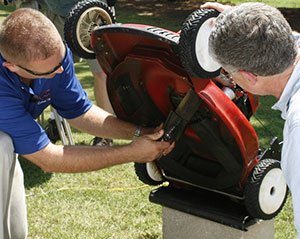Lawn Mower Care and Safety
Many of us spend a lot of time behind a lawn mower, especially in the summer. It’s important to buy one that’s right for the job and to keep it in good working condition.

Choosing a Mower
If you have a moderately sized yard, a manual reel or electric walk-behind mower could be just the ticket. Both are quiet and require very little maintenance. And while the price of a new cordless electric mower may be daunting, you’ll save money in the long run by recharging the battery rather than refilling the tank. Electric and reel mowers are incredibly environmentally friendly, too. According to a report from the EPA, gas-powered lawn and garden equipment is a significant source of air pollutant emissions.
If you’re reluctant to go electric, gasoline-powered walk-behinds are an option. These mowers are powerful and can mulch leaves and clippings, but will need regular maintenance. If you have a lawn larger than half an acre, you might appreciate the ease and speed of a riding mower or lawn tractor. They have many attachments and can even tow a trailer.
Sharpening the Mower Blade
It may seem like a dull chore, but sharpening your lawnmower’s blade is actually one of the best things you can do for your lawn. Regardless of whether you go gas or electric, most mowers work by cutting the grass with a blade. But when the cutting edge is dull, it actually tears the grass instead of slicing it. Torn grass blades make the plants more vulnerable to disease, sun damage, and insects.
Generally, your mower blade should be sharpened at least twice a year. It may need more frequent sharpening depending on the size of your lawn, grass type, and how often you mow.
Rotary mower blades should be sharpened and also balanced, to prevent damage to the mower. Reel mower blades are best sharpened by a professional mower repair service.
Tuning up the Gas-powered Mower
We don’t give our lawnmowers much thought in the winter months, but this is the perfect time to give your gas-powered mower a tune-up. A well-maintained lawnmower uses less gas, has cleaner exhaust, and will last longer. Lawnmower maintenance is very similar to car maintenance, so if you own a car, chances are that most of these tasks are familiar to you.
For best performance, your tune-up should take place every three months, or about every 25 hours of use, and should include several tasks.
An essential step in extending the life of your mower is changing the oil. Disconnect the sparkplug wire before you start. Remove the oil plug and drain the oil into a safe container. Replace the plug without over-tightening. Check the owner’s manual for the recommended oil type. Fill the reservoir with oil, checking the level several times until the dipstick registers full. Replace the dipstick and reattach the sparkplug wire. And don’t forget to dispose of the oil properly. If your engine has an oil filter, replace it as well.
You’ll also want to change the spark plugs. New spark plugs will ensure that your mower engine will start when you need it to. Replace the air filter. Check the owner’s manual to determine the type your mower takes.
Mowing Safety
Every year thousands of people are treated for lawn mower-related injuries. The majority of those treated were children and the elderly. Luckily, it only takes a few simple steps to protect yourself—and your family—from injury.

Mowers are powerful machines with sharp blades, and they warrant careful handling. The most important thing you can do for mower safety is to read your owner’s manual. Wear fitted clothes and sturdy shoes. Eye and ear protection are always a good idea.
Clear the lawn of debris that could be thrown by the mower, like sticks and pine cones, and mow only when the grass is dry.
Keep children out of the yard when you’re mowing. Shut off the mower before adjusting or cleaning the blade, and allow the mower to cool before refueling.
Never carry passengers on a riding mower, and shut off the engine before stepping off your mower.
